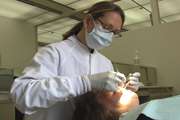Patients with gum disease benefit from osteoporosis drug

A drug marketed to grow bone in osteoporosis patients also works to heal bone wounds in gum disease patients, a University of Michigan study suggests.
"This new approach for the treatment of periodontal disease could allow us to rebuild some of the bone that is lost due to periodontal disease, which until this point has been very difficult to achieve," said Jill Bashutski, clinical assistant professor at the U-M School of Dentistry and first author on the study. "Current treatments to re-grow bone around teeth affected with gum disease have limited success rates."
The findings are significant because gum disease is the leading cause of tooth loss in adults and is associated with a host of other health problems. Periodontal disease results in loss of teeth and can be devastating because it compromises speaking as well as eating, which can in turn contribute to poor nutrition.
The generic name of the drug is teriparatide and it is marketed by Eli Lilly and Co. under the trade name Forteo. It's a type of parathyroid hormone and the only anabolic (meaning it grows bone) osteoporosis drug approved on the market in the United States. Typically, osteoporosis drugs work by preventing bone loss.
The study, "Teriparatide and Osseous Regeneration in the Oral Cavity" appears online in the New England Journal of Medicine Oct. 16 and in the print edition Oct. 28. The study was presented Oct. 16 in Toronto at the annual meeting of the American Society for Bone and Mineral Research.
The study took place at the School of Dentistry's Michigan Center for Oral Health Research, where patients with severe chronic gum disease received the traditional treatment for gum disease, which is periodontal surgery on one-quarter of the mouth. Half of the patients took a six-week course of teriparatide by injection into the skin over the abdomen or stomach, plus calcium and vitamin D supplements, while the other half received a placebo.
After one year, researchers saw a 29 percent improvement in bone-level measurements on x-rays in the teriparatide group, versus a 3 percent improvement in the placebo group, a 10-fold increase.
"I think one really interesting aspect of this study is that even a short dosing of this drug had benefits that lasted a year," said Laurie McCauley, U-M professor and chair of periodontics and oral medicine, and principal investigator on the study.
McCauley's research lab has spent nearly two decades studying how parathyroid hormone works. Animal models suggest that it works even better in certain bone wound-healing situations, such as those that involve surgery, than in osteoporosis, which is a diminishing of the bone rather than a wound.
"There was speculation that the bone that forms in a wound like a fracture or inflammatory disease condition might be more responsive to being built back than other bone," said McCauley, who noted that this proved true in the experimental group.
McCauley said the next step is for U-M researchers to test whether the treatment could be delivered locally to target site-specific bone healing. Forteo is not FDA approved for uses other than osteoporosis, but another possible application could be to help grow bone around dental implants.














